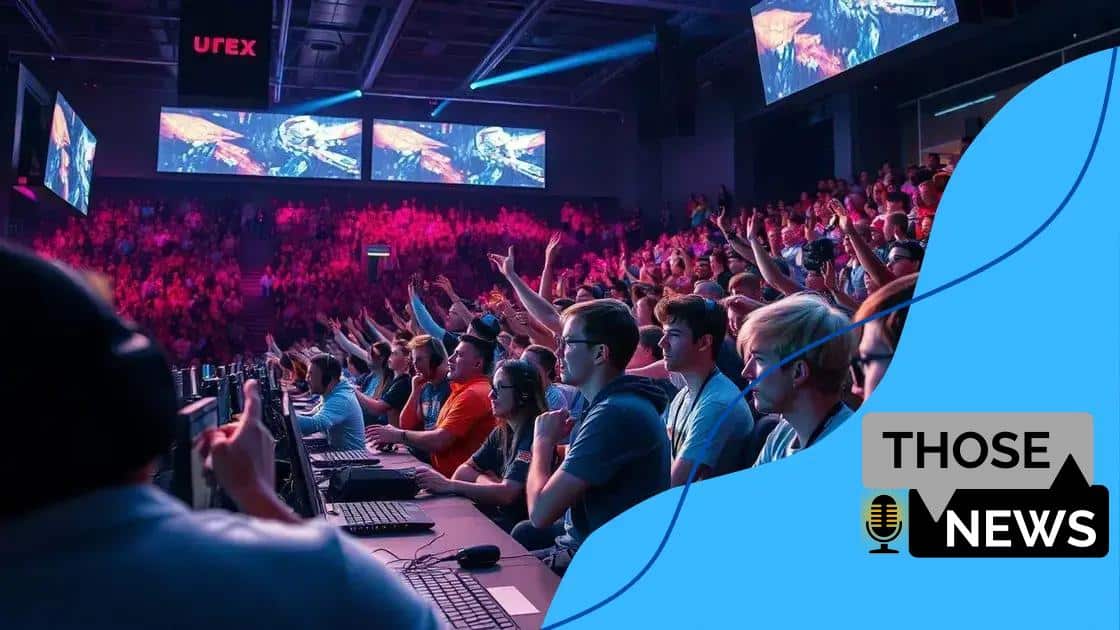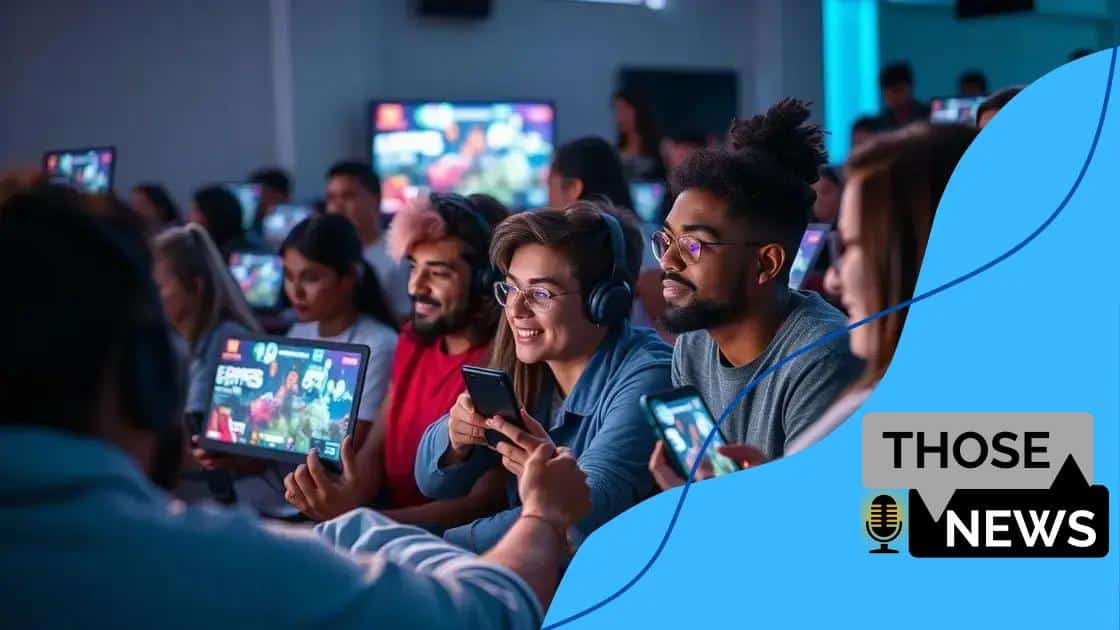How e-sports are influencing mainstream media content

How e-sports are influencing mainstream media content involves integrating technologies like virtual reality, enhancing mobile gaming accessibility, and increasing sponsor investments, shaping the future of entertainment and audience engagement.
How e-sports are influencing mainstream media content is a topic that raises many questions for fans and media professionals alike. With live tournaments attracting millions of viewers, the merger of gaming and traditional media is more apparent than ever. What can we learn from this evolution?
Understanding the rise of e-sports
The rise of e-sports has transformed the landscape of entertainment globally. With millions tuning in to watch competitive gaming, it’s evident that e-sports is not just a trend but a movement. This change has led to increased interest from traditional media and major corporations.
Key Factors Contributing to the Growth
Several factors have influenced the surging popularity of e-sports. First, accessibility plays a crucial role. Anyone with an internet connection can join or watch competitive gaming, making it a global phenomenon. Second, the integration of social media allows fans to engage and share their experiences, creating a vibrant community.
- Accessibility of games and platforms
- Engagement through social media
- Increased investment from sponsors
- Major tournaments offering substantial prizes
Furthermore, streaming platforms like Twitch and YouTube Gaming have redefined how audiences consume content. Gamers can showcase their skills and entertain millions in real time. These platforms have forged connections that traditional media struggled to establish.
The Role of Major Events
Large-scale tournaments, such as The International and the League of Legends World Championship, draw in massive crowds both in person and online. These events not only increase visibility for e-sports but also attract major sponsors and brands looking to connect with a younger audience. The atmosphere at these events is electric, reflecting the passion of both competitors and fans.
As e-sports continue to gain traction, traditional media are increasingly recognizing its potential. News outlets are dedicating segments to e-sports events, and some even host their own tournaments, blurring the lines between traditional sports and e-sports.
In conclusion, understanding the rise of e-sports is crucial to grasping the future of entertainment. As it evolves, it challenges norms and creates new opportunities for both players and fans alike. The intersection of e-sports and mainstream media is only expected to grow, making this an exciting time for all involved.
Key players in the e-sports industry
The key players in the e-sports industry play a significant role in shaping its growth and popularity. Understanding these players helps us appreciate how e-sports has transformed from niche competitions to a booming global phenomenon.
Professional Gamers
At the heart of the e-sports scene are the professional gamers. These individuals dedicate countless hours to honing their skills in various games. Gamers like Faker from League of Legends and n0tail from Dota 2 exemplify this dedication. Their talent draws in fans and keeps them engaged, creating a strong following.
- Top-tier players often have massive online followings.
- Competitors can earn substantial prize money.
- They frequently participate in global tournaments.
- Personalities play a crucial role in brand partnerships.
In addition to players, team organizations have become vital in the e-sports ecosystem. These organizations recruit, train, and promote players. Teams like Team Liquid and Fnatic not only compete but also develop their brands, connecting with fans through social media and merchandise.
Developers and Publishers
Another significant player is the game’s developer or publisher. Companies like Riot Games and Valve create the games that fuel the e-sports scene. Their investment in tournaments and community outreach enhances player engagement. By supporting events, they ensure a robust competitive scene, inviting casual gamers to watch and participate.
Moreover, sponsors and advertisers are crucial for funding events and teams. Brands like Red Bull and Monster Energy have integrated themselves into the e-sports culture, reaching younger audiences and enhancing the viewing experience. Their presence offers financial backing, enabling larger tournaments and better production quality.
Finally, broadcast platforms such as Twitch and YouTube are essential for disseminating content to audiences worldwide. These platforms allow fans to watch live competitions and interact with players directly, creating a community atmosphere that fuels the industry’s growth.
How e-sports are reshaping media consumption

How e-sports are reshaping media consumption reflects a shift in how we engage with entertainment. As audiences increasingly turn to digital platforms, traditional media is adapting to meet these new preferences. This evolution is not only changing what we watch, but also how we interact with content.
The Shift to Streaming Platforms
One of the most significant changes is the migration from cable television to streaming platforms. Viewers are now opting for services like Twitch and YouTube Gaming to watch their favorite e-sports events. This shift offers greater accessibility, allowing fans from around the world to connect over shared interests.
- Viewers can choose which games to watch live.
- Platforms often feature interactive elements, enhancing engagement.
- VOD (Video On Demand) options allow viewers to catch up on missed events.
- Streaming is often free, attracting larger audiences.
Moreover, this shift represents a broader trend where audiences prefer on-demand content over scheduled programming. Traditional media are recognizing this change and adapting their strategies accordingly. Events are now often streamed live, and highlights are shared across social media, maximizing reach.
Impact on Content Creation
This new landscape has also influenced content creation. Media companies are partnering with gaming organizations to produce original shows, behind-the-scenes content, and documentaries. This type of programming resonates well with younger audiences who crave authenticity and connection.
Additionally, personalized content has grown in importance. Algorithms tailor recommendations based on viewing habits, making it easier for fans to discover new games and events. This personalization enhances viewer satisfaction, keeping audiences engaged longer.
Overall, how e-sports are reshaping media consumption signifies a major shift towards more interactive and viewer-driven content. As traditional media embraces these changes, the relationship between audiences and content continues to evolve, highlighting the power of e-sports in influencing modern viewing habits.
The role of sponsors and advertisers
The role of sponsors and advertisers in the e-sports industry is crucial for its growth and sustainability. As e-sports gains popularity, companies are eager to invest in teams, events, and leagues, recognizing the value of reaching an engaged and youthful audience.
Sponsorship Opportunities
Companies from various industries see e-sports as a unique marketing platform. Sponsorship deals can include branding on team uniforms, event signage, and promotional materials. These partnerships not only enhance brand visibility but also connect companies to their target demographics.
- Brands gain access to a young, tech-savvy audience.
- Sponsored events can draw millions of viewers online.
- Engaging with fans through giveaways and exclusive content boosts loyalty.
- Companies can demonstrate their commitment to the gaming community.
Major brands like Intel and Red Bull have made significant investments in e-sports, supporting tournaments and creating unique experiences for fans. These partnerships contribute to the overall production quality of events, lifting the standard of e-sports competitions.
The Impact of Advertising
Advertising in e-sports is also evolving significantly. Traditional ads are replaced by more engaging content tailored to the audience. Advertisers use strategies like in-game advertisements and interactive campaigns during live streams to connect with viewers effectively.
Additionally, social media and streaming platforms allow for targeted advertising, ensuring that messages reach the right audience. This leads to higher conversion rates, which is a win-win for both advertisers and the gaming community.
As a result, the relationship between e-sports and its sponsors is becoming increasingly symbiotic. While sponsors provide essential financial support, they also benefit from the vibrant and passionate audiences that e-sports offers. Together, they help shape the future landscape of the e-sports industry.
Future trends in e-sports and media
Future trends in e-sports and media suggest an exciting evolution as technology continues to advance. As the industry grows, new innovations will reshape how fans engage with competitive gaming.
Integration of Virtual Reality
One emerging trend is the integration of virtual reality (VR)
Another key trend is the rise of mobile gaming. As smartphones become more powerful, e-sports competitions on mobile platforms are gaining traction. Games like PUBG Mobile and Call of Duty Mobile attract millions of players and viewers. This accessibility opens e-sports to a wider audience, enabling more fans to participate and engage. The future of streaming platforms also looks bright. With the success of platforms like Twitch and YouTube Gaming, content creators will continue to drive e-sports popularity. Fans enjoy watching streamers and professional players interact in real-time. This connection fosters a strong community around games. Additionally, the rise of exclusive content is likely to affect the media landscape significantly. Streaming platforms may invest in original programming about e-sports, including documentaries, talk shows, and tournaments. This will attract both existing fans and newcomers to the world of competitive gaming. Furthermore, the increased collaboration between traditional media and e-sports could bring more diverse content. Broadcasting e-sports events on cable channels might reach new audiences, bridging the gap between gaming and traditional sports. The future of e-sports and media is bright and full of possibilities. As technology evolves, new trends will shape how fans enjoy competitive gaming. From virtual reality experiences to the rise of mobile gaming, the connection between e-sports and its audience will only strengthen. With sponsors and advertisers continuing to invest in the industry, we can expect even more exciting content and opportunities. The merging of e-sports with traditional media will create a unique landscape, paving the way for a thriving community that embraces innovation. Ultimately, e-sports will redefine entertainment for generations to come. Key trends include virtual reality integration, the rise of mobile gaming, growth of streaming platforms, and increased sponsorship investments. Virtual reality offers immersive experiences that allow fans to feel as if they are part of the action, enhancing engagement and community connection. Mobile games are accessible and attract a larger, diverse audience, making e-sports more inclusive and engaging for new players. Sponsors provide essential funding and resources, while also gaining visibility and connection to a younger audience through engaging content and events.
Growth of Streaming and Content Creation
FAQ – Frequently Asked Questions about E-sports and Media Trends
What are the main trends shaping the future of e-sports?
How is virtual reality changing the e-sports experience?
Why are mobile games important for e-sports growth?
How do sponsors and advertisers influence e-sports?





